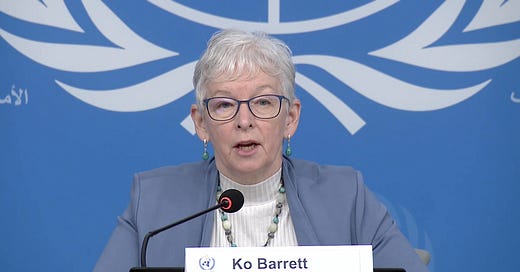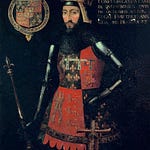Scroll all the way. Subscribe to read and watch our interviews.
WMO
World Meteorological Organization
WMO is the UN agency for, you guessed it, meteorology. This week its Deputy Secretary-General, Ms. Ko Barret, spoke to the UN press corps about the alarming rate of anthropogenic impact on extreme weather events. See Spain’s flash foods.
Watch and listen carefully. Not surprised, just wondering why is it taking so long for governments to push financing for the energy transition. A question that will be asked in the upcoming UN Climate Change Conference, starting soon. What does CoP stands for? Conference of the Parties, CoP29. #UNClimateConference #Baku
WHO
World Health Organisation
First Global Model WHO took place in Geneva
The first in-person Global Model WHO, hosted by World Federation of United Nations Associations and WHO in Geneva, gathered 350 youth delegates from 52 countries to simulate the World Health Assembly. Subscribe for our upcoming interview with William Yotive, the lead on the first partnership between a UN agency and Model UN.
They drafted resolutions on issues like climate change, mental health, and pandemic preparedness. In th last day youth delegates adopted a declaration calling for a global Pandemic Agreement, emphasizing coordinated global action. A historic event as was the first time that a Model UN gathering prepared and presented such a document.
WHO Director-General, Dr. Tedros Adhanom Ghebreyesus, said the event empowers young leaders in health policy and advocacy. #WHO #GlobalHealth #PublicHealth
G20 in Rio de Janeiro
How to Fundraise One Billion +
Health ministers from around the world gathered in Rio for the G20
Brazil’s Minister of Health, Nísia Trindade, urged countries to support the World Health Organization’s (WHO) new Investment Round, a funding call to increase WHO’s capacity to address pressing global health challenges.
WHO Director-General Dr. Tedros Adhanom Ghebreyesus “asked every Member State and partner to participate, according to their means.”, explaining that the WHO had already received 63 pledges totaling over one billion dollars, including significant contributions from first-time donors in Africa, the Western Pacific, and South-East Asia.
Brazil’s leadership in the meeting reflects its commitment to the WHO and its mission, a focus that President Luiz Inácio Lula da Silva will carry forward as he chairs the G20 Leaders’ Summit later in November.
Germany’s Health Minister, Dr. Karl Lauterbach, followed Trindade’s remarks with a similar call for support. “A strong WHO is essential for the world,” he said. “Reliable and sustainable financing is essential for WHO. Financing WHO means investing in a healthier future.” He called on G20 partners to turn their commitments into action by providing predictable, flexible financial support.
Interview with Paul Saffo
Alvin Toffler’s Future Shock, Noam Chomsky’s essay on the New York Review of Books The Responsibility of Intellectuals, and Paul Saffo’s Atlantic Council 2024 Global Foresight, offer us rigorous thinking, by public intellectuals that study the past and read the seemingly incongruent sparks of the present to forecast the future.
We should heed their insights and teachings.
I was lucky growing up.
My father was a visionary broadcast journalist, according to the historian of television news in Brazil, Walmor Bergesch, (dad would chuckle at this, he was modest to a fault, he was just plugged-in in the present, in the evolution of broadcast news).
Subscribe for full access and to watch interview.
In the 60s and 70s and later, when he was appointed senior spokesperson for the Brazilian Ministry of Science and Technology, our house invited books, people, and ideas from intellectual luminaries from Brazil, all of Europe, and the US.
My father would look at my son, when he was just two years old, in 1985, and say: “when goes to university he will not use paper notebooks, he will write in a personal computer, a sort of touchscreen mobile device”, (the laptop moniker had not yet been invented). He was of course reading the signals, the markets, and reading tech policy reports from the US government.
14 years later I purchased a blue iMac desktop for my son to play video games and do his school assignments. In 2008 I bought a laptop for him to do his work at university.
The future had arrived, 14 and 23 years later, respectively.
After attending the Geneva Science and Diplomacy talks I am curious as to what 2025 will bring us. So I am calling on all forecast anthropologists and foresight experts.
In this interview with Paul Saffo, that I was lucky to book, we speak about the history of forecasting, and how businesses and people should be all plugged-in to foresight trends in their industry and how it will affect them personally.
We also spoke about the Oracle of Delphi, the first successful “management consulting firm” in the history of humankind, its state secrets, and what happened to Alexander the Great when he visited the Oracle of Siwa, in Egypt. And how “ideas in Silicon Valley take 20 years to become an overnight success”.
Watch.
Fear of Missing Out?
Check our AI FOMO Weekly Wrap-up
Here’s a summary of this week’s latest AI updates across major players, along with links to their original sources:
Subscribe for full access.
1. Anthropic Updates: Anthropic’s Claude now supports PDF image analysis, has a Claude 3.5 Sonnet model available on GitHub, and introduced dedicated apps for Mac and Windows. Additionally, users can dictate messages on iOS and Android.
- Source: 9to5Mac https://9to5mac.com/2024/10/31/claude-mac-app
2. OpenAI Updates: ChatGPT’s revamped search is rolling out, Advanced Voice Mode is now on MacOS and Windows, and chat search history features are on the way for free users.
- Source: OpenAI Blog https://openai.com/blog/
3. Poe by Quora: Poe has integrated Runway’s Gen-3 Alpha Turbo model, enhancing its generative capabilities within its interface.
- Source: Poe’s Twitter https://twitter.com/poe
4. Recraft Version 3: This new release offers significant text-to-image capabilities that surpass competitors, positioning it as a powerful generative tool.
- Source: Recraft’s Website https://recraft.ai/
5. Runway ML: Runway launched advanced camera controls, allowing for better manipulation of zoom, angle, and movement.
- Source: Runway’s Website https://runwayml.com/
6. Stability AI: Stability AI introduced the lightweight Stable Diffusion 3.5 Medium model, designed for efficient usage.
- Source: Stability AI Blog https://stability.ai/
7. Wonder Dynamics: A beta feature from Wonder Dynamics can now turn videos into 3D animated scenes.
- Source: Wonder Dynamics https://wonderdynamics.com/
UN Conference on Biodiversity
More and Better Segmented Financing Needed
How much exactly?
$20 billion per year in biodiversity finance by 2025.
COP16 in Cali, Colombia, concluded with mixed results. The summit saw some significant achievements, including the creation of the “Cali Fund,” a new financial mechanism intended to share benefits derived from digital sequence information (DSI) of genetic resources.
COP16 yielded promising initiatives like the Cali Fund and sectoral integration efforts but fell short on essential financial agreements, jeopardizing the broader goals of the KMGBF.
This fund will ensure that companies profiting from DSI contribute to biodiversity conservation, with 50% of the fund earmarked for Indigenous Peoples and local communities.
While the Cali Fund represents a step forward, critical financial agreements related to broader biodiversity goals were postponed, casting doubt on the effective implementation of the Kunming-Montreal Global Biodiversity Framework (KMGBF).
Kirsten Schuijt, Director General of WWF International, acknowledged Colombia’s efforts in facilitating negotiations but noted that suspending discussions threatened the goal to halt and reverse biodiversity loss by 2030.
Schuijt stressed that the global community cannot afford further delays in committing resources to biodiversity protection, especially as financial commitments are essential to reach the 2030 targets.
One of the key stumbling blocks was a wider biodiversity fund that would have targeted developing countries.
Negotiations around this broader fund were suspended, leaving unresolved financial gaps in supporting developing nations in meeting biodiversity targets.
This deadlock reflects ongoing tensions between donor and developing countries, with developed nations lagging on their commitment to contribute $20 billion per year in biodiversity finance by 2025.
Pledges to the interim Global Biodiversity Framework Fund (GBFF) reached only $407 million, far short of the necessary funding.
According to Bernadette Fischler Hooper from WWF-UK, the discussions on biodiversity finance were marked by discord, underscoring long-standing divisions between donor and recipient countries that have yet to be bridged.
Despite the financial setbacks, progress was made in other areas.
COP16 saw advances in integrating biodiversity across various sectors, launching a new government-led “Mainstreaming Champions Group,” supported by 18 Parties.
The adoption of an action plan on biodiversity and health, as well as measures to designate Ecologically Biologically Significant Areas (EBSAs) in oceans, signaled important steps toward protecting 30% of ocean areas by 2030.
Another notable development was the focus on aligning biodiversity efforts with climate action. Parties committed to better coordination between National Biodiversity Strategies and Action Plans (NBSAPs) and Nationally Determined Contributions (NDCs) under the climate agreements, with COP29 approaching in Baku.
Participation from Indigenous Peoples, local communities, Afro-descendants, women, and youth reached new heights, making COP16 a truly inclusive event.
Dr. Lin Li from WWF International called COP16 the “People’s COP” due to the diverse representation and the platform it provided for communities whose livelihoods and cultures are directly affected by biodiversity loss.
Sandra Valenzuela, CEO of WWF Colombia, noted that the adoption of the Article 8(j) work program, which ensures Indigenous participation in the Convention on Biological Diversity, and the Subsidiary Body’s formation were landmark decisions that strengthen Indigenous rights in conservation efforts.
While the increased inclusivity and commitment to biodiversity and climate alignment were positive, the failure to secure adequate funding for biodiversity finance left a critical gap. The outcome reveals both progress and persistent challenges in global biodiversity conservation, with urgent actions needed from developed countries to meet financial commitments if the 2030 goals are to be achieved.















Share this post